
Ove Edfors, Andreas F. Molisch, and Fredrik Tufvesson
WIRELESS COMMUNICATIONS
Lecture slides for courses based on the
textbook by A. F. Molisch
Slides for “Wireless Communications” © Edfors, Molisch, Tufvesson 1
Wireless
Communications
2
nd
edition

2Slides for “Wireless Communications” © Edfors, Molisch, Tufvesson
Textbook
Textbook

4Slides for “Wireless Communications” © Edfors, Molisch, Tufvesson
Contents
• What are radio systems?
• History of wireless systems
• Classifications
• Requirements for services
• Social and economic aspects

6Slides for “Wireless Communications” © Edfors, Molisch, Tufvesson
Radio system?
• From Merriam-Webster Dictionary
– Radio:
1 : of, relating to, or operated by radiant energy
2 : of or relating to electric currents or phenomena (as electromagnetic
radiation ) of frequencies between about 15 kHz and 100 GHz
– System:
1 : a regularly interacting or interdependent group of items forming a
unified whole
• ”Radio systems” can be used for many purposes, e.g.
– Detection and ranging (Radar)
– Astronomical observation (Radio telescope)
– Heating food (Microwave oven)
– Navigation (GPS, etc.)
– Communication (Cellular telephony, etc.)

7Slides for “Wireless Communications” © Edfors, Molisch, Tufvesson
Some questions to ask
• What do we want to achieve with our system?
– This gives us design constraints (system requirements)
• What frequency band should we use?
– Properties of the radio channel changes with frequency
– Radio spectrum is firmly regulated
• Which technology should we use?
– Not all technologies can perform the task
– Cost is important (design, production, deployment, etc.)
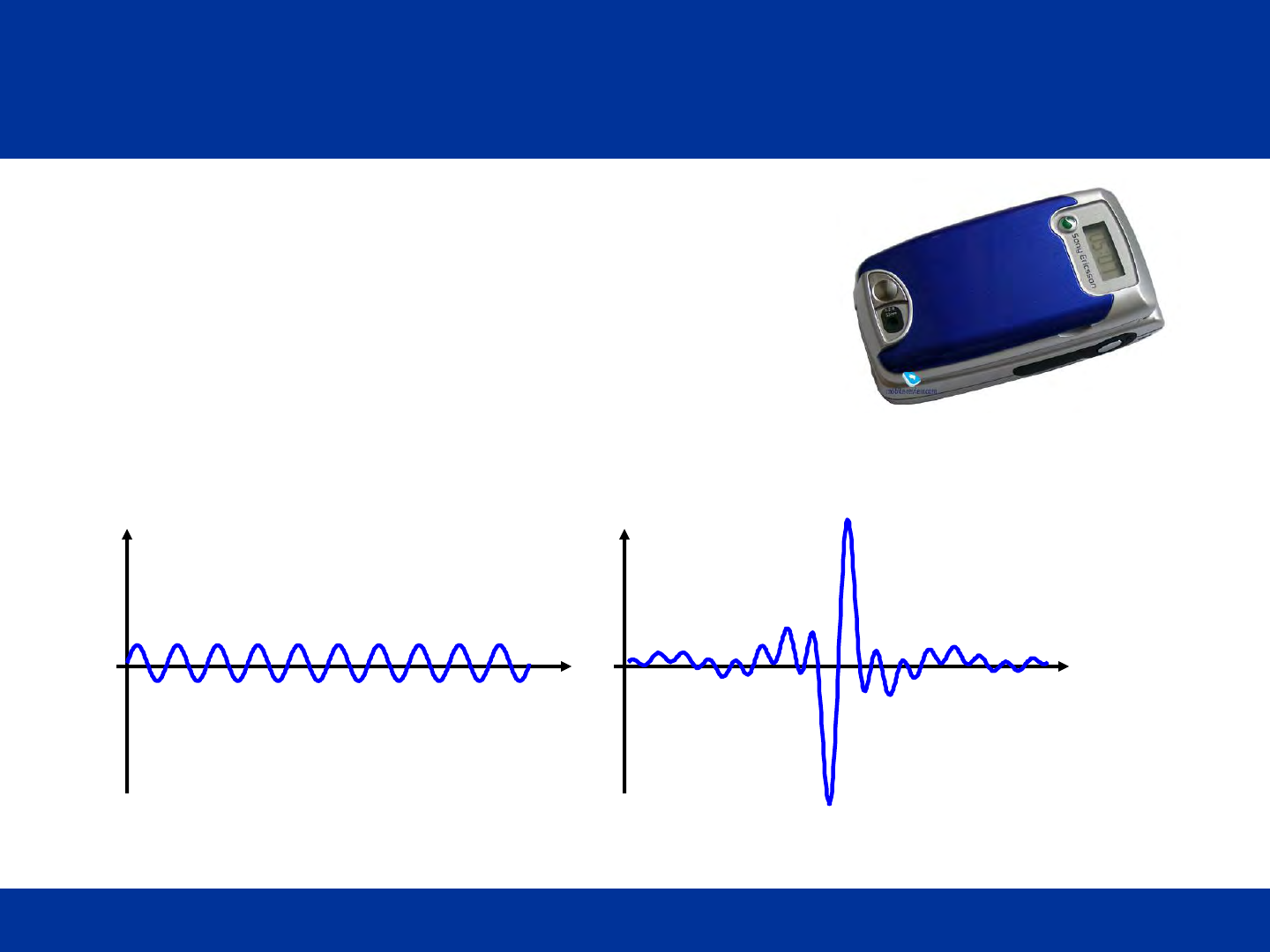
8Slides for “Wireless Communications” © Edfors, Molisch, Tufvesson
Example: Mobile telephony
Amplifiers with low dynamic range can be
made more power efficient than highly
linear amplifiers.
Does this affect the choice of modulation
technique?
Radio signal Radio signal
Copyright: Sony-Ericsson

9Slides for “Wireless Communications” © Edfors, Molisch, Tufvesson
A rough breakdown into areas
Fundamental problems
in wireless communications
Propagation
and antennas
Deterministic Probabilistic
Channel models
Narrow-band
channels
Wide-band
channels
Antennas
Digital transmission
over wireless channels
Modulation
Speech and
channel coding
Equalization
Diversity
Mobile communications
systems
Multiple access
Cellular telephony
Wireless data networks
Cordless system

10Slides for “Wireless Communications” © Edfors, Molisch, Tufvesson
HISTORY OF WIRELESS

11Slides for “Wireless Communications” © Edfors, Molisch, Tufvesson
History of wireless (1)
• Maxwell: theory
• Hertz: fundamental experiments confirming Maxwell’s
theory
• 1890-1905: First experiments for wireless information
transmission
– Tesla, Bose, Marconi
• 1905-1946: First systems:
• 1947/1948: fundamental information theory
(Shannon)
using a spark gap driven by a Rumkorff coil, 26 years after Maxwell developed the complete
theory of the electromagnetic field.
original work was 20 differential equations in 20 unknowns later reworked by Oliver
Heaviside into a vector notation creating just 4 vector differential equations in 2 unknowns
that we use today.
Shannon Capacity Formula: C = B log(1 + SNR) where log is base 2 and
C = channel capacity in bps, B = bandwidth in Hz, SNR = ratio of transmit power / noise power both in watts



Wireless Comes of Age
• Guglielmo Marconi invented the wireless telegraph in 1896
• Communication by encoding alphanumeric characters in analog signal –
continuous wave (CW)
• Sent telegraphic signals across the Atlantic Ocean
• “It is dangerous to put limits on Wireless” - Guglielmo Marconi, 1932
• Communications satellites launched in 1960s
• Advances in wireless technology
• Radio, television, mobile telephone, communication satellites – initially
RF based analog systems in the VHF/UHF spectrum
• More recently
• Satellite communications, wireless networking, cellular technology –
digital modulation schemes in the UHF/microwave spectrums
• Big Picture/Overall Viewpoint
• Two types of wireless systems: WiFi (802.11) and Cellular (example 4G
LTE) both of which provide access to the Internet

Copyright © 2011, Dr. Dharma P. Agrawal and Dr. Qing-An Zeng. All rights reserved
1
The History of Mobile Radio Communication (1/3)
1880: Hertz – Initial demonstration of practical radio communication
1897: Marconi – Radio transmission to a tugboat over an 18 mi path
1921: Detroit Police Department: -- Police car radio dispatch (2 MHz
frequency band)
1933: FCC (Federal Communications Commission) – Authorized four
channels in the 30 to 40 MHz range
1938: FCC – Ruled for regular service
1946: Bell Telephone Laboratories – 152 MHz (Simplex)
1956: FCC – 450 MHz (Simplex)
1959: Bell Telephone Laboratories – Suggested 32 MHz band for high
capacity mobile radio communication
1964: FCC – 152 MHz (Full Duplex)
1964: Bell Telephone Laboratories – Active research at 800 MHz
1969: FCC – 450 MHz (Full Duplex)
1974: FCC – 40 MHz bandwidth allocation in the 800 to 900 MHz range
1981: FCC – Release of cellular land mobile phone service in the 40 MHz
bandwidth in the 800 to 900 MHz range for commercial operation

Copyright © 2011, Dr. Dharma P. Agrawal and Dr. Qing-An Zeng. All rights reserved
2
The History of Mobile Radio Communication (2/3)
1981: AT&T and RCC (Radio Common Carrier) reach an agreement to
split 40 MHz spectrum into two 20 MHz bands. Band A belongs to
nonwireline operators (RCC), and Band B belongs to wireline
operators (telephone companies). Each market has two operators.
1982: AT&T is divested, and seven RBOCs (Regional Bell Operating
Companies) are formed to manage the cellular operations
1982: MFJ (Modified Final Judgment) is issued by the government DOJ.
All the operators were prohibited to (1) operate long-distance
business, (2) provide information services, and (3) do
manufacturing business
1983: Ameritech system in operation in Chicago
1984: Most RBOC markets in operation
1986: FCC allocates 5 MHz in extended band
1987: FCC makes lottery on the small MSA and all RSA licenses
1988: TDMA (Time Division Multiple Access) voted as a digital cellular
standard in North America
1992: GSM (Groupe Speciale Mobile) operable in Germany D2 system

Copyright © 2011, Dr. Dharma P. Agrawal and Dr. Qing-An Zeng. All rights reserved
3
The History of Mobile Radio Communication (3/3)
1993: CDMA (Code Division Multiple Access) voted as another digital
cellular standard in North America
1994: American TDMA operable in Seattle, Washington
1994: PDC (Personal Digital Cellular) operable in Tokyo, Japan
1994: Two of six broadband PCS (Personal Communication Service) license
bands in auction
1995: CDMA operable in Hong Kong
1996: US Congress passes Telecommunication Reform Act Bill
1996: The auction money for six broadband PCS licensed bands (120 MHz)
almost reaches 20 billion US dollars
1997: Broadband CDMA considered as one of the third generation mobile
communication technologies for UMTS (Universal Mobile
Telecommunication Systems) during the UMTS workshop conference
held in Korea
1999: ITU (International Telecommunication Union) decides the next
generation mobile communication systems
(e.g., W-CDMA, cdma2000, etc)

Copyright © 2011, Dr. Dharma P. Agrawal and Dr. Qing-An Zeng. All rights reserved
4
First Generation Cellular Systems and Services
1970s Developments of radio and computer technologies for
800/900 MHz mobile communications
1976 WARC (World Administrative Radio Conference) allocates
spectrum for cellular radio
1979 NTT (Nippon Telephone & Telegraph) introduces the first
cellular system in Japan
1981 NMT (Nordic Mobile Telephone) 900 system introduced by
Ericsson Radio System AB and deployed in Scandinavia
1984 AMPS (Advanced Mobile Phone Service) introduced by
AT&T in North America

5
Generational Cellular Systems
1G (1981) - Analog Voice (AMPS)
2G (1991) - Digital Voice (GSM, IS-95)
3G (2000) - Internet Data (WCDMA, CDMA2000)
4G (2008) - Broadband data (LTE, WiMax)
5G (2020) - ??? massive connectivity

Wi-Fi (Radio) Communication Progress
Not Cellular Communication Systems

14Slides for “Wireless Communications” © Edfors, Molisch, Tufvesson
TYPES OF SERVICES

15Slides for “Wireless Communications” © Edfors, Molisch, Tufvesson
Broadcast

16Slides for “Wireless Communications” © Edfors, Molisch, Tufvesson
Paging
Medical personnel still use a pager
system integrated into their cell
phones

17Slides for “Wireless Communications” © Edfors, Molisch, Tufvesson
Cellular phones
Majority of the data load is carried
by hi-speed wired systems (fiber, copper)

18Slides for “Wireless Communications” © Edfors, Molisch, Tufvesson
Cordless phones

19Slides for “Wireless Communications” © Edfors, Molisch, Tufvesson
Wireless LANs and PANs
Mesh Networks
Author needs to add WiFi/802.11
infrastructure networks which use
routers for wired networks and access
points (AP) for wireless networks.
Note that the 802.11 standard does
incorporate ad-hoc networks.
(also P2P / peer-to-peer network)


20Slides for “Wireless Communications” © Edfors, Molisch, Tufvesson
Fixed wireless and satellite
• Fixed wireless systems
– Long distances between BS and MS
– No mobility requirements
– Typically high data rates, but can also be used for voice systems
– WiMax standard (IEEE 802.16)
• Satellite systems
– Cover very large area
– No high density (Erlang/km^2)
– Iridium system with LEO systems tried to get large user density, but
progress considerably slower than anticipated (10 new satellites
just launched in January 2017 by SpaceX with more to follow)

21Slides for “Wireless Communications” © Edfors, Molisch, Tufvesson
REQUIREMENTS FOR SERVICES

22Slides for “Wireless Communications” © Edfors, Molisch, Tufvesson
Data rate
• Sensor networks: <1kbit/s; central nodes need up to 10
Mbit/s
• Speech communications: 5-64 kbit/s, depending in speech
coder (vocoder)
• Elementary data services: 10-100 kbit/s
• Communications between computer peripherals: 1 Mbit/s
• Wireless LANs: broadband internet speeds, 1-100 Mbit/s
• Personal Area Networks: >100 Mbit/s
Nyquist Criterion
Data rates 2 years old so already out of date USB3 is 4.8 GBPS for computer peripherals
cellular LTE 300 Mbps down/75 Mbps up
LTE Advanced 3 Gbps down/1.5 Gbps up

23Slides for “Wireless Communications” © Edfors, Molisch, Tufvesson
Tradeoff range vs. datarate
for current rates probably move all the services up

24Slides for “Wireless Communications” © Edfors, Molisch, Tufvesson
Mobility
• Fixed devices: stay in one location; temporal variations due
to moving objects in surroundings
• Nomadic devices: MS placed at certain location, stays there
for a while (WLANs)
• Low mobility: pedestrian speeds (cordless phones)
• High speed: cellphones in cars
• Extremely high speed: high-speed trains, planes, ….
Spectrum Usage - limited resource, cellular uses ISM 2.4 GHz and 5 GHz
bands, 5G Systems will undoubtedly use millimeter frequencies

26Slides for “Wireless Communications” © Edfors, Molisch, Tufvesson
ECONOMIC AND SOCIAL IMPACT

27Slides for “Wireless Communications” © Edfors, Molisch, Tufvesson
Economic requirements
• Systems where mobility is a value by itself
– Cellphones, etc.
– Can charge premium for service
• Systems that just are cable replacement
– e.g., for fixed wireless access
– Must be cheaper than cabled service
• In either case, quality has to be same as wired
• Systems should contain as many digital components as
possible to reduce costs and allow the power of
computers to be applied to the problems

28Slides for “Wireless Communications” © Edfors, Molisch, Tufvesson
Behavioral impact
• Communications are now with a person, not with a location
• Allows more flexibility for private/business life, but can also
become electronic “ball and chain”
• Cellphone etiquette: generally underdeveloped
• Phoning while driving is dangerous
• Each cellphone has an OFF button

Copyright © 2011, Dr. Dharma P. Agrawal and Dr. Qing-An Zeng. All rights reserved
8
Subscriber Growth
3G Subscribers
2G Digital only Subscribers
1G Analogue only Subscribers
Subscribers
Year
Dated 2011 but
where is 4G?

Mobile Device Internet Usage Accelerating
• Mobile broadband
usage growing rapidly
‒ New subscribers to
broadband services
‒ Quad core
smartphones
‒ Laptops and tablets
‒ M2M
• Network intensive
applications
‒ Video
• Mobile data 2011-2016 78% CAGR compound annual growth rate (Source: Cisco VNI Mobile, 2012)
‒ Mobile video traffic exceeded 50 percent for the first time in 2011
‒ Average smartphone usage nearly tripled in 2011
‒ 150 MB per month (up from 55 MB per month in 2010)
‒ average smartphone will generate 2.6 GB of traffic per month in 2016 (17x 2011)

Changes Since Yesterday (2013)
The mobile data tsunami is driving the need for diverse, distributed network
deployments.
4G LTE (Long Term Evolution) is the advertised solution in the US. This is an
engineering solution based on four main features: a modulation technique
Orthogonal frequency-division multiplexing (OFDM), multiple input/multiple
output (MIMO) technologies (from 802.11n), highly efficient error correction
techniques (Turbo Codes) and real-time network adaptability to user loads. LTE
is a packet-switched network only (vs circuit-switched networks like GSM and
CDMA)
LTE (note the word Evolution) will continue to evolve as computer processing
capabilities continue to improve (Moore’s Law, muticore processors, etc.)
Heterogeneous network deployments provide higher data rates and QoS (Quality
of Service) for users at affordable CAPEX (capital investment) & OPEX
(operational expenses) for service providers.
Companies are providing complete, scalable hardware & software solutions
from femto (< 15 users) to macro cell in order to build wireless communications
networks from a large entity (company, conference, Flash Mobs, etc.) to a
personal residence communications network for the wireless devices in a house.

LTE Is Significant Step Forward
• LTE provides 2 to 5 times greater spectral
efficiency than most advanced 3G networks
– Lower cost per bit
• Faster downloads
– Up to 100 Mbit/s initially
– Better user experience
•
Reduced OPEX and CAPEX (operational & capital expenditures)
– LTE base station cost <1/5 HSPA cost per user per
month (based on 10 Gbit/s per month)
– Energy efficient

LTE Market Rollout
• 592 Million LTE Subscriptions by 2016 (Source: Pyramid Research)
• 4G LTE Revenues Projected to Exceed $265 Billion
Globally in 2016 (Source: Juniper Research)
• 417 LTE Devices Announced (Source:GSA)
– From 67 companies
• 89 LTE operators have now launched commercial
services in 45 countries (Source:GSA)
– 80 FDD, 9 TDD
– Additional 61 expected to start
services during 2012
2009
2010
2011
2012
2
17
47
89
61
Source: GSA Evolution to LTE report July 11, 2012

Evolving Multi standard Radio Access
Networks (cellular connectivity diagramed)
Next generation
Antenna Integrated
Radio Unit
Source: ALU, NSN, Ericsson, Verizon
Iub
Iub
S1-MME
S1-U
Different standards are consolidated
into one base station
Converged multi
standard macro base
stations and
small cells (micro
main-remote, and
pico)
Wi-Fi
Packet Switched
Circuit Switched
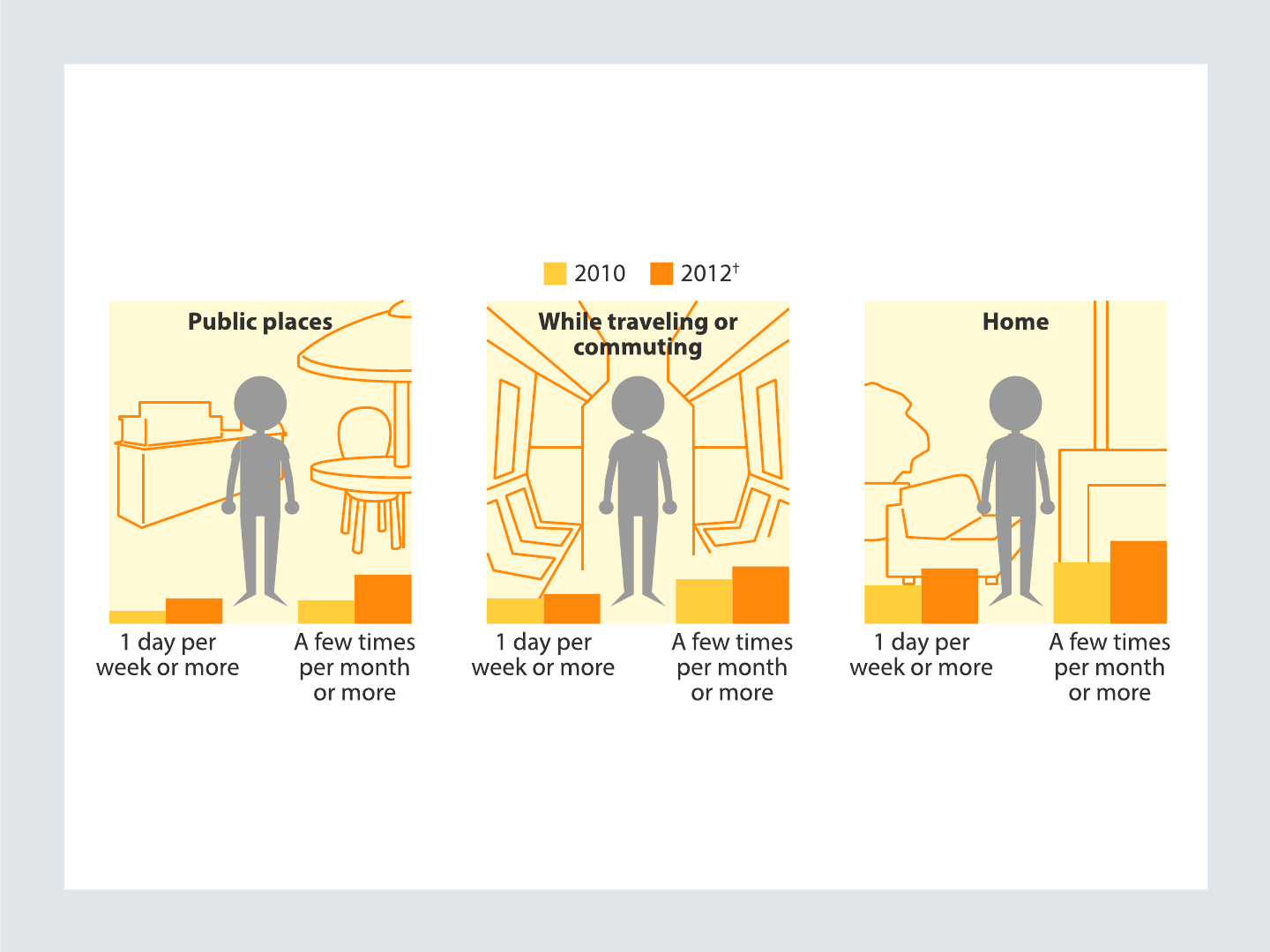
Employees at all levels are more
autonomous and mobile than ever

Employees use multiple devices to
complete work activities
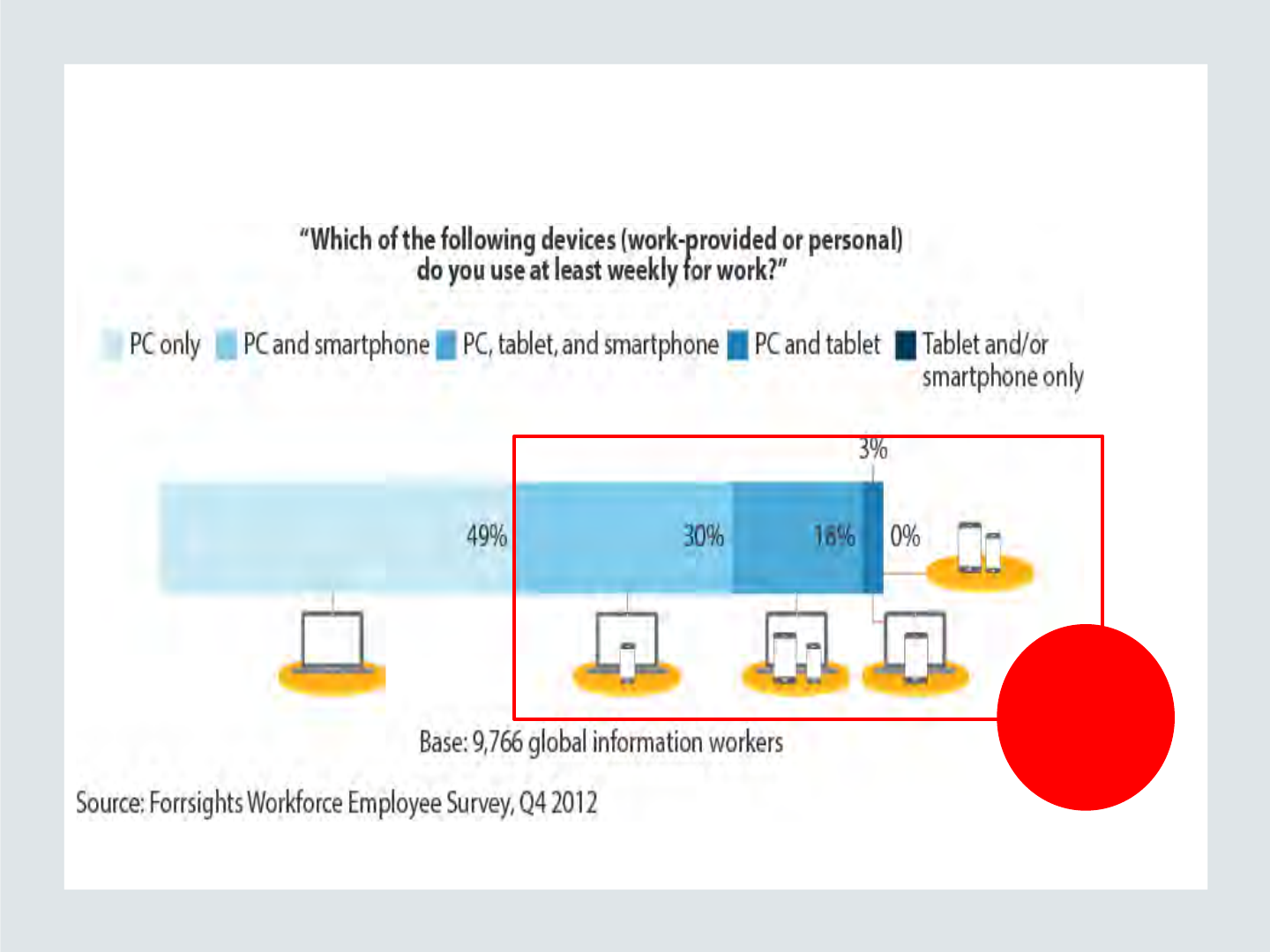
Workers have quickly added smartphones and
tablets to their repertoire of devices…
51%

… but they want the trifecta: PC, tablet, and
smartphone – some 80% of workers!
80%

Employees are Willing to Pay More
to Choose Their Tools Each Year
© 2013 Forrester Research, Inc. Reproduction Prohibited
12
Source: Forrsights Workforce Employee Survey, Q3 2010, Q3 2011 and Q3 2012
CAREER-FOCUSED EMPLOYEES ARE 4x MORE WILLING TO PAY TO CHOOSE!

© 2013 Forrester Research, Inc. Reproduction Prohibited 13
Source: Forrsights Mobility Survey, Q2 2013
26%
44%
59%
2013 2015 2017
Base: 2258 Mobile telecommunication decision makers
The empowered era will create new variables not
experienced on the wired side
“What is the amount of network traffic will cross over wireless?” (50% or more of traffic)
Internet 91%
Email 89%
Social Media
70%
Hi def video 62%
VDI 61%
UC and Collaboration 58%
Virtual Desktop Infrastructure - desktop on a virtual
machine that lives on a server in a data center
unified communcations
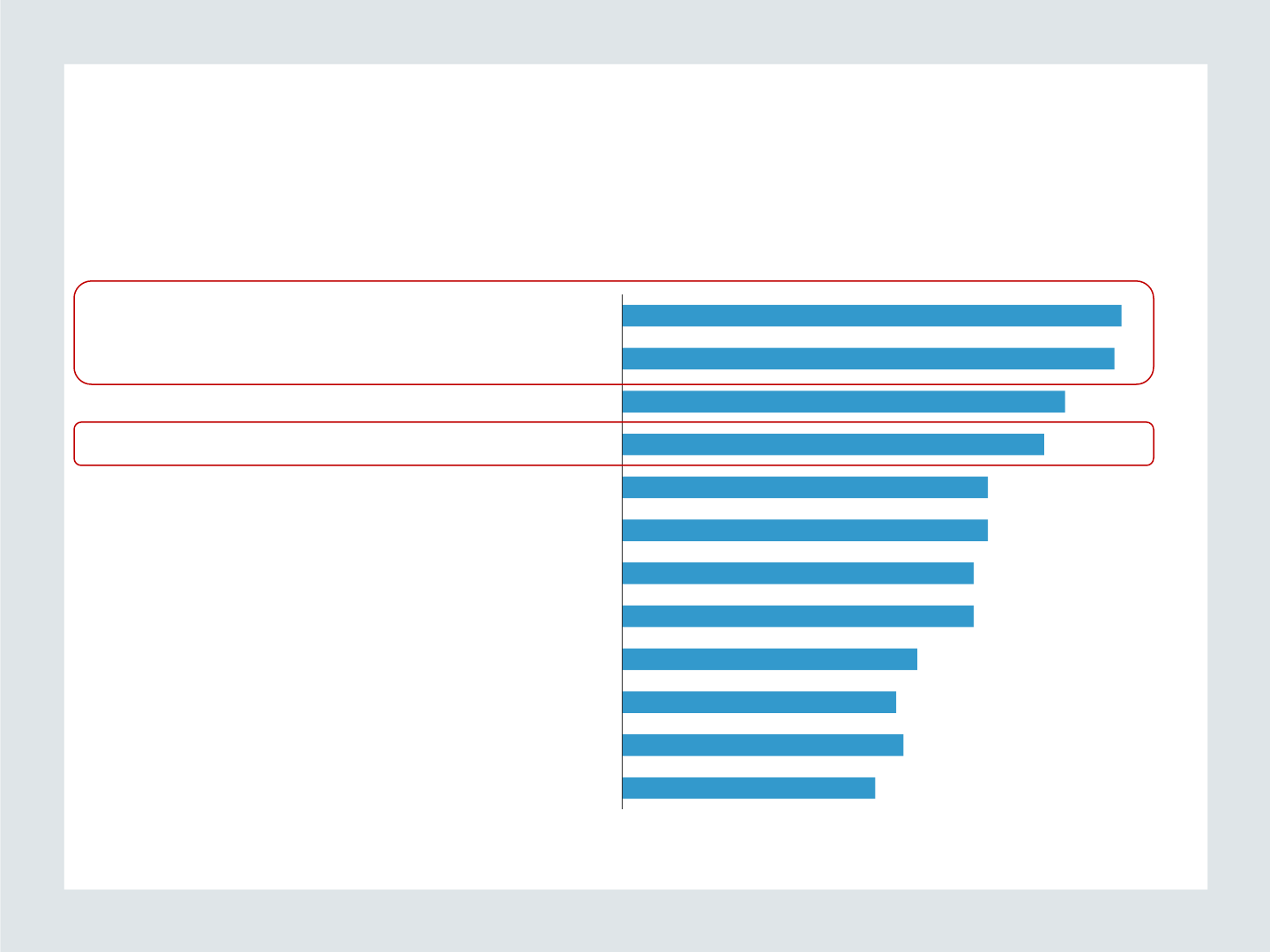
Source: Forrsights Networks And Telecommunications Survey, Q1 2013
“Which of the following initiatives are likely to be your firm's top strategic network and telecommunications
priorities during the next 12 months?”
(Respondents selecting High or Critical priority)
36%
40%
39%
42%
50%
50%
52%
52%
60%
63%
70%
71%
Expand machine-to-machine or 'Internet of things' initiatives
Adopt/expand use of 'as-a-service' delivery of telecommunications
services using multitenant/shared infrastructure
Adopt/expand use of software-defined networks
Use some/more third-party managed telecom/communications
services
Rationalize or consolidate communications product and equipment
vendors
Migrate our networks to an all-IP environment
Rationalize or consolidate telecom/communications service
providers
Adopt/expand use of over-the-top communication solutions
Provide more mobility support for customers and business partners
Move some/more applications to the cloud
Enhance enterprise network bandwidth capacity
Provide more mobility support for employees both outside the office
and within our facilities
Base: 2144 IT decision makers
Mobility and device diversity shift attention
back to the network

Source: Forrsights Mobility Survey, Q2 2013
“What are your firm's plans to adopt the following mobile and wireless network technologies/services?”
Base: (Variable) mobile telecommunication decision makers in companies with more than 20 employees
…and Wi-Fi will be the dominant way to
connect
13%
15%
16%
18%
22%
19%
35%
28%
40%
73%
ZigBee (802.15 or similar)
Femtocells
Picocells
Satellite/VSAT
HSPA+
WiMAX
3G public cellular network
Long-term evolution (LTE)
Public Wi-Fi network
In-house WLAN/Wi-Fi
Implemented/Expanding/Planning next 12 mo.
74% respondents
are focused on
making wi-fi the
primary way to
connect

21
@arubanetworks
IEEE Standards Development: Process Flow – 802.11ac
Source: https://mentor.ieee.org/802.11/dcn/10/11-10-0617-01-0000-ieee-standards-process-overview.ppt and
http://www.ieee802.org/11/Reports/802.11_Timelines.htm, http://standards.ieee.org/develop/policies/opman/sb_om.pdf
Ide
a
Project
Approval
Process
Develop Draft
Standard in
Working Group
Sponsor
Ballot
IEEE SA
Standards Board
Approval
Publish
Standard
Standard is Active; can be
transferred to Inactive status,
reviewed every 10 years
Maximum of 4 years, + extensions
2008
Oct
2008
2009-2012 2013 Dec 2013 Dec
2013
802.11ac Dates

23
@arubanetworks
• Wi-Fi CERTIFIED™ ac certification is now
available
• Launched June 2013
• 229 products certified to date, see https://
www.wi-fi.org/wi-fi-
certified%E2%84%A2-products
• Based on IEEE 802.11ac draft 5.0
• Expect a “Final ac” certification in 2-3 years
• Wi-Fi Alliance to update the program to include additional
features and ensure backward compatibility with previously
certified devices
• Additional optional features to be added, as with 11n
• Availability 2015/2016
Wi-Fi Alliance Interoperability Certification
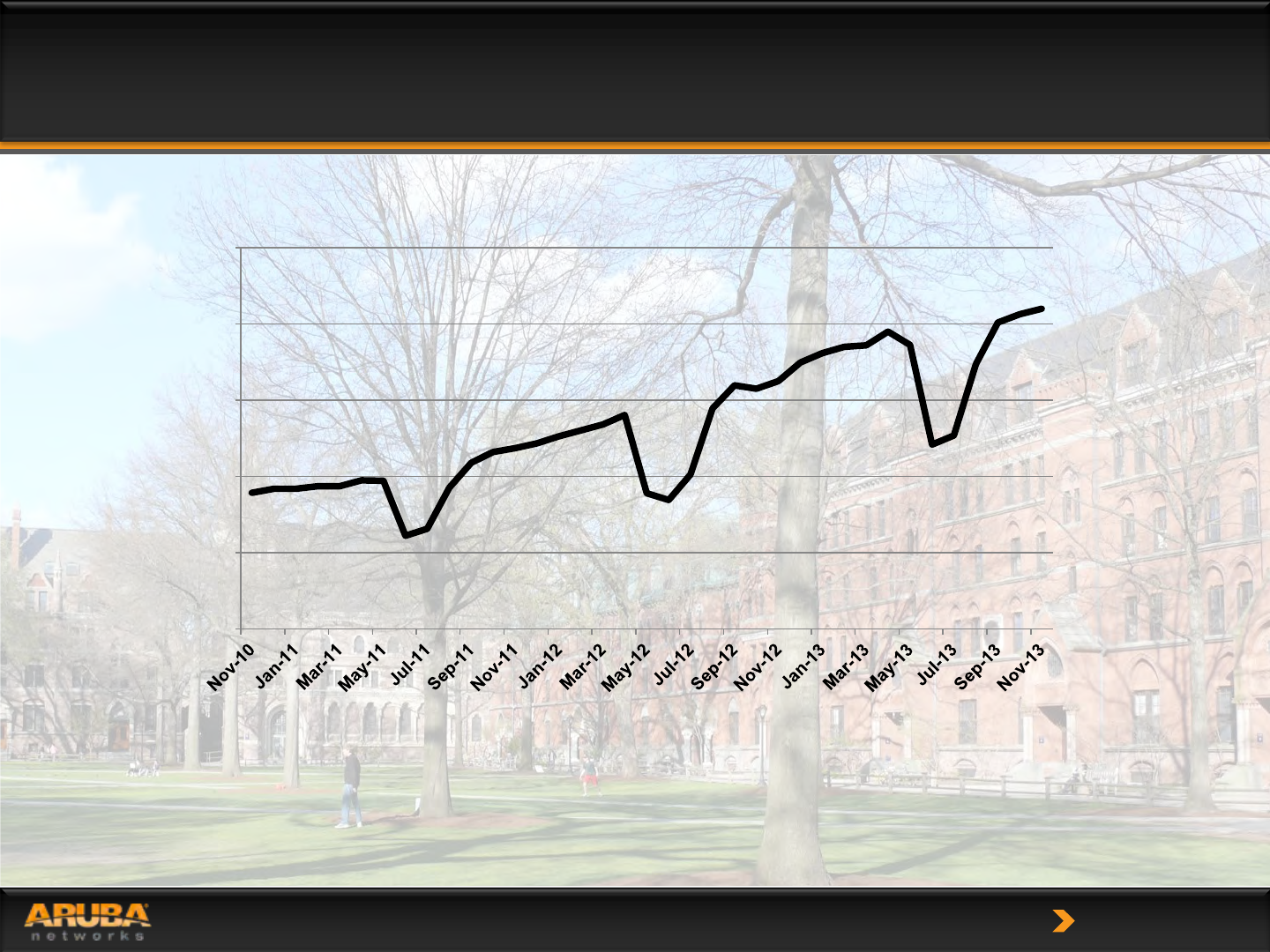
25
@arubanetworks
• >30% annual growth in devices on campus past 3 years
• Since deploying 802.11ac Access Points, seeing
over 5% of devices are 802.11ac
Growth in Connected Devices at Yale University
0
5,000
10,000
15,000
20,000
25,000
Connected Clients

Copyright © 2011, Dr. Dharma P. Agrawal and Dr. Qing-An Zeng. All rights reserved
9
Macrocell
Suburban
Coverage Aspect of Next Generation Mobile
Communication Systems
Microcell
Urban
Satellite
Global
Global
Picocell
In-building

Copyright © 2011, Dr. Dharma P. Agrawal and Dr. Qing-An Zeng. All rights reserved
10
Transmission Capacity
Global System for Mobile Communications
0.01 0.1 1 10 100
Transmission capacity as a function of mobility in some radio access systems
Mobility
Universal
Mobile
Telecommunicat
ions System
Mobile Broadband System
Broadband Satellite Multimedia
Local Multipoint Distribution System
Satellite Universal Mobile
Telecommunications
System
Data rate (Mb/s)
Stationary
Pedestrian
Vehicular

Copyright © 2011, Dr. Dharma P. Agrawal and Dr. Qing-An Zeng. All rights reserved
11
Wireless Technology and Associated
Characteristics
Cellular
Wireless LAN/PAN
GPS
Satellite Based GPS
Home Networking
Mesh and Ad Hoc Networks
Sensor Networks
Bluetooth

Copyright © 2010, Dr. Dharma P. Agrawal and Dr. Qing-An Zeng. All rights reserved
30
Satellite Systems
Traditional Applications
Weather satellite
Radio and TV broadcasting
Military satellites
Telecommunication Applications
Global telephone connections
Backbone for global network
GPS

Copyright © 2010, Dr. Dharma P. Agrawal and Dr. Qing-An Zeng. All rights reserved
31
Network Architectures
and Protocols
Systematic Signaling Steps for Information
Exchange
Open Systems Interconnections (OSI)
Transmission Control Protocol (TCP)
Internet Protocol (IP)
Internet Protocol Version 4 (IPv4)
Internet Protocol Version 6 (IPv6)
Mobile IP

Copyright © 2010, Dr. Dharma P. Agrawal and Dr. Qing-An Zeng. All rights reserved
Some Definitions
Baseband – modulation techniques that do not use a
sinusoidal carrier but encodes information directly as the
amplitude, width of position of a pulse. PAM – pulse
amplitude modulation PWM – pulse width modulation
Bandpass – modulation techniques that encode
information as the amplitude, frequency or phase of a
sinusoidal carrier. FSK – frequency shift keying, PSK –
phase shift keying, AM, FM
35

Broadband Wireless Technology
• Higher data rates obtainable with broadband wireless
technology
• Graphics, video, audio
• Shares same advantages of all wireless services:
convenience and reduced cost
• Service can be deployed faster than fixed service
• No cost of cable plant
• Service is mobile, deployed almost anywhere
• Ubiquitous Computing (Mark Weiser/Xerox Parc) – “ The most
profound technologies are those that disappear. They weave
themselves into the fabric of everyday life until they are
indistinguishable from it.”

Limitations and Difficulties of Wireless
• Mobility brings unique challenges of its own, has had a
significant impact on lifestyles and society in the last five
years.
• Too Big to Fail?
• Lack of an industry-wide standard, which should be a
concern to the global community (but the global economy
will mandate a solution)
• Device limitations
• Power
• Data Consumption
• Throw away device, impacts of 2 year cellular contracts, electronics waste
• Security – Achilles heel of the technology
• RF Effects – long term effects on humans? Environment?
• Economics – industry in spite of its size is still impacted by
the economy.

Why This Course?
• A very hot technology that has become a multi-billion
industry with numerous job opportunties.
• Wireless is convenient and less expensive, low deployment
costs, great for countries without a wired infrastructure.
• Already an integral part of business and our lifestyle.
• Data rates are improving significantly faster than anticipated
and in time will no longer be a limitation, especially when
wireless data rates reach the processing bandwidth of the
human eye
• Eventually everything will be wireless !! Large Job Opportunties
• A communications technique that will become fully
integrated with our bodies in terms of our clothes and maybe
even our brain.

Why Not This Course?
• If it heats up quickly, it will also cool down just as fast (low
specific heat)
• Course time limitations limit development of a fundamental set of
‘knowledge’ tools. Limited hands-on opportunities.
• Design, test and deployment is computer aided with new tools
being introduced every day. Very difficult to stay ‘current’.
• RF design is somewhat of a black art and not a large career field
• Governments are under pressure to open more spectrum for
wireless applications (recent 108 MHz of analog TV channel
spectrum available when digital TV became the standard) – all
leading to a extremely dynamic landscape, probably unstable.
• What are the real job qualifications? Just about every engineering
job will touch wireless communications in some manner.
• Conclusions - Flexibility is the keynote of life. No substitute for
experience.
